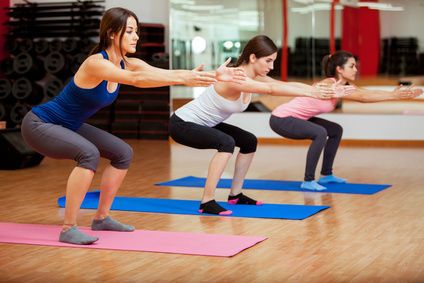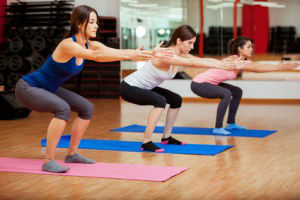
When you think of exercise, is the first thought that pops into your head that of you endlessly pedaling away on a stationary bike? If the thought of long sweat sessions in the gym is a major turnoff, then listen up.
One of the best exercises you can do for your entire body requires no gym equipment and can be done practically anywhere. And you don’t even have to do it every day for hours on end to see results. Check out these eight reasons why you should start squatting today:
Benefits Beyond the Legs: Squats are more than just a leg exercise. When performed correctly, the squat will utilize several major muscle groups including glutes, abs and back muscles.
Mega Muscle-Builder: The squat is a full-body exercise, meaning that several muscle groups are utilized throughout each set. This type of exercise promotes the release of testosterone and human growth hormone, which encourage muscle growth.
A Fat-Flusher: While it’s true that cardio exercise is a great way to torch calories, in reality you will reap more benefits by adding muscle. Muscle burns more calories at rest than fat. By performing muscle-building exercises two to three times a week, your body will become more efficient at burning calories even after you’ve left the gym.
Injury Avoidance: Nothing can be as devastating to an athlete as an injury. Squats help strengthen the stabilizing muscles of the legs, core and back, as well as the connective tissue surrounding joints, which will keep you off the injured list.
Banish Back Pain: A major culprit of back pain is tight back and leg muscles coupled with a weak core. Squats bring several joints in the body through a full range of motion, which enhances flexibility while building core strength. A steady diet of squats will help eliminate back pain for good.
A “Real-World” Exercise: Think of how often you perform a bicep curl in your day… probably not often. Now think of how often you have to squat down or lift yourself up. Squats are a functional exercise, meaning that they replicate movements our bodies do in real-world situations. Become more efficient in your everyday movements and you’ll reduce your risk of injuries, sprains, aches and pains.
Performance-Enhancer: Whether you are an active athlete or a weekend warrior, the squat has been proven to aid in better athletic performance. In fact research has shown that athletes who incorporated squats into their fitness routine performed better in both running and jumping tests than those who didn’t.
A Balance-Builder: Many older adults struggle with balance as they age. Falls are a cause of many injuries that can lead to serious complications when bed-rest is required. Strengthening stabilizing muscles will help prevent balance loss and will keep you out of a doctor’s office and out of a cast!
Steps for Squatting Correctly
Like any exercise, when performed incorrectly squats can strain the muscles or put too much pressure on the joints. Follow these steps to ensure you are squatting with proper form:
 Stand with your feet about shoulder-width apart.
Stand with your feet about shoulder-width apart.- Keep your knees centered over your feet, and the weight evenly dispersed on your feet (don’t lean onto the balls of your feet).
- Slowly lower into a squat by bending your knees, hips and ankles until you reach 90 degrees and return to the starting position.
- (Tip: You can place a stability ball against the wall and lean your back on it until you are comfortable with the exercise. This will keep you from leaning too far forward or losing balance.)
- Repeat this exercise for 15–20 reps for each set and begin with two or three sets. You only should perform the sets two to three times each week. Once the exercise becomes easy you can add weights or incorporate upper-body exercises like bicep curls into the squat.
-The Alternative Daily
Sources:
http://fitness.mercola.com/sites/fitness/archive/2012/05/25/darin-steen-demonstrates-the-perfect-squat.aspx#_edn1
http://www.mensfitness.com/training/pro-tips/get-stronger-7-reasons-to-never-neglect-squats
http://bjsm.bmj.com/content/38/3/285.abstract

